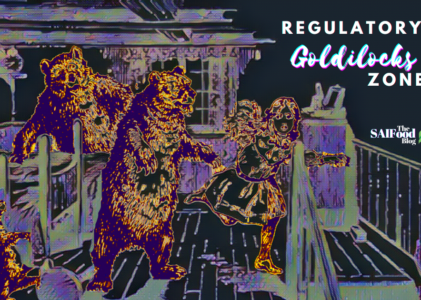Finding the ‘not too much’ or ‘not too little’ sweet spot
It’s often said that there’s a fine line between too much and not enough of many things in life and society. Astronomers that search for potentially habitable planets circulating stars have coined the phrase ‘Goldilocks Zone’ as the range of distance from these stars that a habitable planet could feasibly exist. This concept is from the Goldilocks and the Three Bears fable, which is similar to young Goldilocks’ search to find that ‘just right’ sweet spot, we need to take into consideration all important variables. Similar to finding another habitable planet, the Goldilocks Zone concept can aptly be applied to numerous areas, such as regulations. For instance, if a regulatory framework for a product is not sufficiently rigorous enough, unsafe products could enter the market, harming consumers or the environment. In the efforts to ensure we thoroughly consider all possible variables, we might find that we end up ignoring the variables that impact whether we find the sweet spot, which are time and cost. If the regulatory framework is too rigorous, the time and cost to get products to the market will be too high, resulting in the regulatory framework acting as a barrier. We have seen fear become a timely and costly barrier for developments in new nuclear reactors and they have impeded genetically modified breeding technologies around the world.
Problems from inefficient regulations
We routinely take comfort in the efficacy of our regulatory systems, as they protect us from unsafe products entering the market. However, no system is capable of operating at 100% certainty. Eventually, an unsafe product will enter. While this is quite rare, it does happen.
It is not uncommon that unsafe products slip into our systems from time to time, we just may not be as aware if we aren’t searching for it or haven’t been issued a notice. Evidence of unsafe products entering the market can be seen when vehicle manufacturers issue recall notices to replace or repair specific makes and models. Similar recall notices are issued to food safety and regulatory agencies when unsafe food products are identified. Product failures even exist in the health sector, whether is sunscreen, Covid-19 test kits, or the more publicized news when as was thousands of women experienced leakage problems with silicone breast implants.
Regulatory systems need to ensure they are structured to manage proven risks. Proven risks are those that have well established theory and evidence supporting the theory. Essentially, these risks can be quantified in parts per million or parts per billion. Regulatory systems should not be designed or used, to manage the risks of hypothetical or speculative risks. Hypothetical risks are those that have some theory of risk, but lack quantified evidence of risk. Speculative risks are those that lack both theory and evidence.
Problems from overly cautious regulations
Regulatory systems that focus on precaution rather than risk, ultimately implement systems that are incapable of functioning efficiently. Science-based regulatory systems are capable of appropriately quantifying the level of risk and ensuring that the risks are managed in such a way so that products entering the market are safe. Inefficiencies in risk management result in systems that are tilted towards the precaution side of the pendulum and are rooted in hypothetical and speculative risks, creating regulatory frameworks that serve as barriers to the commercialization of products.
When barriers to commercializing products are too high, investments into the sector decrease. This can have negative impacts on the economy, as fewer new products enter the market, resulting in less competition to keep prices down. New technologies commonly lower the cost of producing products and when regulatory barriers are high, these innovations fail to occur, meaning that the rate of innovation falls and the market price of the products remains higher than would be the case if the burden of regulation was eased.
Are regulatory Goldilocks Zones achievable?
The answer to this is, without a doubt: YES. However, it takes commitment to science-based evidence and possessing the political fortitude to revise regulatory frameworks, even if this means reducing the regulatory burden. Regrettably, many in society see any reduction in regulation as a weakening of the efficacy of the system. The problem with this attitude is that it is common that regulations can be based on outdated technology or information and revision and reducing regulatory requirements increases products entering the market with no impact on the safety of the products. The ability of activist organizations and social media to create a firestorm of negative messaging for governments intent on reducing regulatory burdens can certainly make the appeal of reducing regulatory burdens politically unappetizing. Frequently the important intentions to reduce regulatory burdens can be sidetracked due to the political pressures brought to bear. We only have to look at how mainstream media is far more interested in promoting negative news stories than positive.
Regulatory efficiency is crucial to the effective operating of innovation systems. The level of global information about safety and risk assessment is well known and widely accessible. Drawing on this pool of knowledge can contribute to efficient regulatory frameworks. Regulatory failures are very rare and the majority of the regulatory problem lies with the other end of the spectrum, in that regulatory systems are overly rigorous, which have little to no scientific justification. The importance of doing this certainly outweighs the political fallout that might develop from reducing regulatory requirements.

